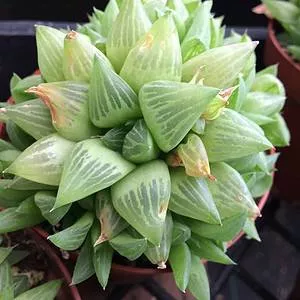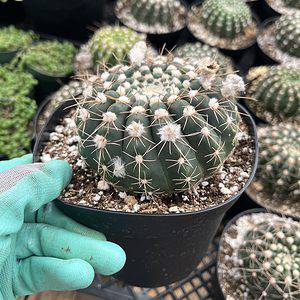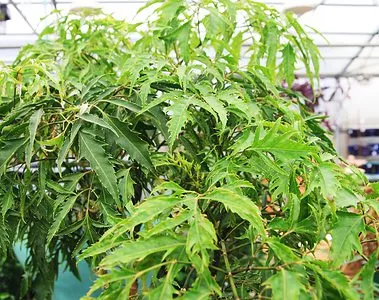No products in the cart.
Table of Contents
Anthurium clarinervium is sure to become an eye-catching houseplant in your living space. The plant that belongs to the Aroid family will stop anyone in their tracks with eye-dropping gorgeous dark green deeply lobed heart-shaped leaves with contrasting white veins.
More About Anthurium Clarinervium
Did you know that this plant Anthurium clarinervium leaf thickness is called coriaceous, or “leather-like” in botanical terms? The thick texture of its leaves makes it an unusually intriguing plant.
The plant’s enormous, heart-shaped leaf is renowned for its beautiful pale green, gold, or silver-toned concentric veins on a darker green background. Anthurium clarinervium is still semi-rare.
It is one of the most sought-after plants for a stunning foliage houseplant. Buying and selling this plant is still considered a major game being played today in the plant community,
It’s also a flowering plant with vibrant solid-color blooms, which adds to its appeal. These flowers are distinct from other flowers because they lack petals.
The blossom has the appearance of a brightly colored leaf with a thick, velvety texture and a lustrous sheen. Anthurium clarinervium common name is velvet cardboard anthurium.
Want to add this Anthurium clarinervium to your tropical garden? Can you see yourself looking at the stunning foliage houseplant standing in your living room? Well, you are in the right place!
We will also teach you how to care for such beauty. Please read below to find out more!
Anthurium Clarinervium Plant Care Basics

Anthurium clarinervium is a tropical plant and epiphyte that grows in its natural habitat along with other plants and tree branches in Mexico. Hence, it needs unique soil to grow. Still, the velvet cardboard anthurium grows smaller than most other plants in the species, making it ideal for the home.
Indoors the leaves will reach up to six inches or larger.
Here is the plant’s overview. We’ve provided them in a table form so that it will look easy for you. Plus, you can gain more knowledge about what this plant is like.
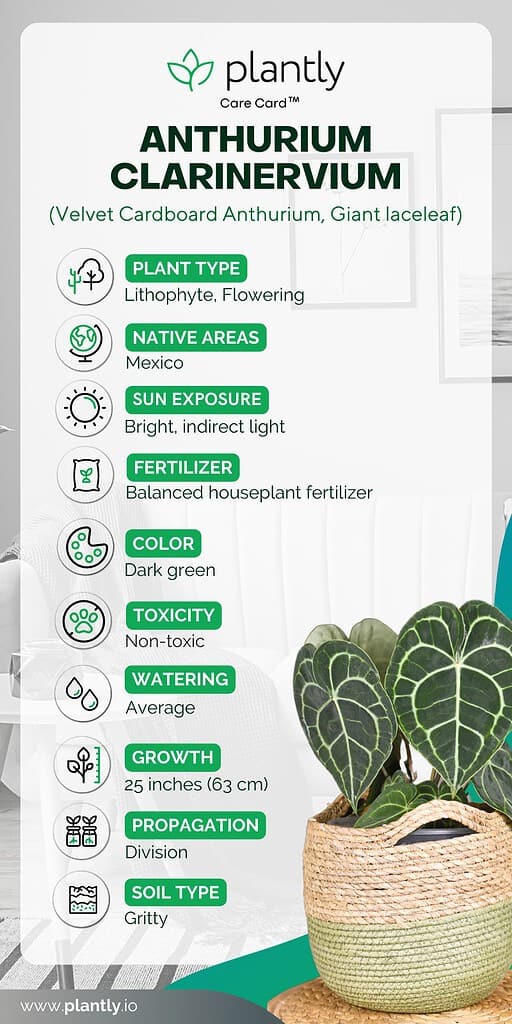
Already gained knowledge about this Anthurium clarinervium? Never stop here, my friend! We will explain each of those below. There’s more to find out.
Best Potting Mix

One of the critical requirements for the plant’s growth is to have the proper soil mix made of organic matter. The aerial roots need regular access to oxygen without drying out; if the mixture is too wet, it leads to root rot.
A loose, chunky mix is preferable to a finer gradient because the medium should be open enough to let the roots breathe even after soaking. You might begin by mixing 1 part orchid bark with 2-3 parts of your favorite all-purpose potting mix.
This will provide them with the excellent drainage they require to grow. So your anthurium plants need well-draining soil and do not stand wet soil.
Watering Needs
Clarinervium plants do not require water on a daily basis. Even though the plant enjoys dampness, it does not prefer regular watering. Overwatering will saturate the plant’s soil, halting the growth and functions of the roots.
To avoid inflicting damage on the plant, it is critical to maintain it adequately hydrated with the necessary water. After the water has done draining, make sure to empty the saucer.
Pro tip: Before rewatering, wait until the top inch or two of the soil has dried up. If the soil quality is good, this will imply watering once a week, but don’t stick to a schedule: keep an eye on the soil!
Lighting
Although lesser light is sometimes recommended for Anthurium clarinervium, it requires bright indirect light exposure to thrive. It will also prevent the plant from getting leggy. In direct sunshine or in high heat, this indoor plant will die. Burns can occur if the plant is subjected to too much heat or a high temperature.
In the summer, extra caution should be exercised to avoid damage from excessive heat.

Pro tip: In general, an Eastern exposure is preferable. They can put up with the early morning sun and enjoy the long hours of strong indirect light that follow. In addition, this plant slows down in winter and requires less light.
Temperature & Humidity
The Anthurium clarinervium plant is temperature and heat-sensitive but loves warm temperatures. So, the ideal temperature for this beauty is 53.6 and 73.4 °F (12 and 23 °C).
The plant may freeze if the temperature drops below 53.6 degrees Fahrenheit. On the other hand, the plant and its leaves may burn if the temperature rises beyond 73.4 °F.
So keep an eye out for this beauty at your home. You can move the plant to the best spots around the house, depending on your climate. But don’t move it too much because they are sensitive to it also.
Another essential feature of Anthurium clarinervium care is high humidity. Although the plant enjoys dampness, excessive exposure should be avoided.
The edges of the plant’s leaves will begin to brown if it is subjected to low humidity. One approach to achieve this is to mist every day to every few days, depending on how dry the air is.
It’s also a good idea to put the plant in a room with a humidifier to ensure proper humidity. Placing a pebble and water-filled tray in the bottom of the pot is an easy technique to ensure humidity for your plant.
Fertilizer
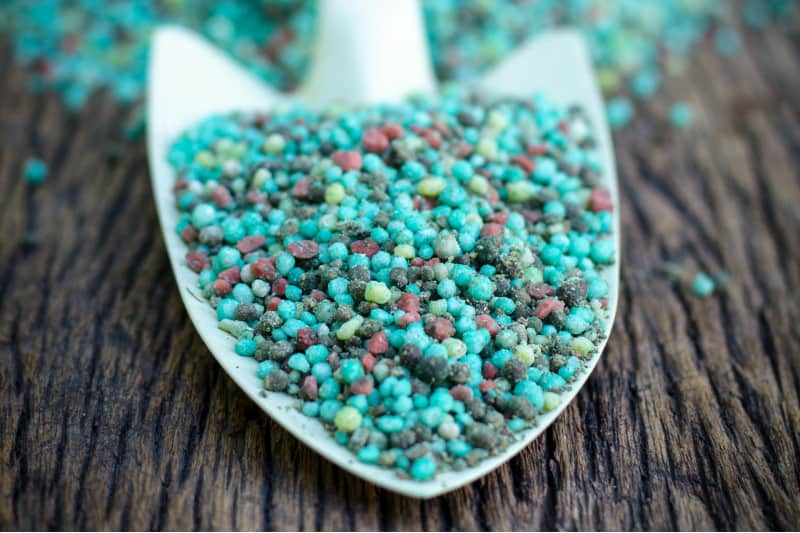
Plant growth is aided by the addition of good plant fertilizer. Fertilizers are also required to increase their sturdiness. Wild Anthurium clarinerviums fight out a living in rocky crags on scant soil, so they aren’t heavy feeders.
But if you do fertilize it, you should do it during the growing season (Spring and Summer). You can do it once a month using a balanced houseplant fertilizer diluted to half strength.
Pro tip: Residual fertilizer can build up and toxify the soil over time. It’s a good idea to flush it out by allowing extra water to run through with each watering.
Anthurium clarinervium Propagation
Propagating Anthurium clarinervium is not too difficult, even if it is your first time. I know you’ll get the hang of it soon. You can use stem cuttings, but division is the easiest way to propagate mature plants.
You should do this during Spring to give them an entire season of growth. The most excellent and most convenient time for division is usually during repotting.
Here’s how you will do it:
Unpot the plant gently and separate small offsets or stem sets, ensuring each has roots and at least one leaf.
Plant the divided piece in the same potting medium as the mother plant. Water the soil around the roots to settle it.
Provide the same circumstances for the young plant or seedlings as for the adult plant: high humidity, warmth, and medium-to-bright indirect light. It is also quite beneficial to have good air circulation.
You can then see roots forming in a few weeks. Once it has established its root system, you can transfer individual plants to a permanent pot adding some orchid bark to your potting soil.
Growth Zone
The Anthurium clarinervium is hardy in USDA zones 9b-11.
Potting

For young Anthurium clarinervium plants, 1-gallon indoor pots are a perfect size. Depending on the growth rate of your indoor plants, you may need to move them to larger planters.
When it comes to repotting, you can do this when the roots fill the container and begin to round the pot. A mature specimen should be checked every two or three years.
When shifting plants into larger pots, a typical rule is to use larger sizes than the existing pot. This will ensure it has enough room to form roots and thrive in its new environment.
Then provide your plants with fresh soil of sphagnum moss, peat moss, and all the healthy goodies we mentioned earlier. It is also an excellent time to check the root ball for any damage to remove the unhealthy roots.
Pruning
Anthurium clarinervium care needs minimal pruning. But you will need to do some essential grooming. Before pruning the plant, look at its leaves and remove the dead or damaged leaves.
You can also clip any leaves that are turning brown or overly long. Wilted blossoms should also be removed to keep the foliage looking good. Spotted leaves should also be clipped to prevent them from spreading throughout the plant.
It can survive even if just four leaves are left on the stem. Yet, severe pruning is not recommended because it can cause damage and not lead to new growth.
Anthurium Clarinervium Varieties and Similar Plants
Anthuriums have gotten a lot of press lately and for a good cause. This fascinating, diversified family includes popular flowering houseplants and tropical exotics with some of the world’s most beautiful foliage. And I know you want to know some of these beauties, right?
Don’t worry because we will also provide them for you. They are:
Anthurium crystallinum
 Anthurium crystallinum @Ahmad Fuad Bin Morad
Anthurium crystallinum @Ahmad Fuad Bin Morad
Each suede-like oval leaf has a deep, textured green color as its background. The hue of young leaves is faint, but as they age, they get darker. Some farmers claim that the plant can withstand a humidity level of 55 percent.
Anthurium magnificum

Anthurium Magnificum’s thick, velvety leaves can grow to be over two feet long, and the white veins aren’t the most detailed or pronounced. It also has a significant amount of venous exposure. A thin black edge runs along the bottom of the leaf.
New leaves emerge as a brilliant reddish-brown that turns green over time.
Anthurium forgetii

A ring of electrifying white veins surrounds a velvety green surface on this attractive round-leaved cultivar. The purple edge on the green spathe is complemented with a yellow spike that reddens and produces purple berries.
This outdoor plant remains tiny enough to be used as a tabletop ornament.
You may also check our article Best Anthurium Varieties You Can Grow at Home for more beautiful anthurium varieties you can choose.
Anthurium Clarinervium Diseases & Pests
Pests
Different pests are attracted to the Anthurium clarinervium. Because of the plant’s broad, thick leaves, pests can easily hide and go unnoticed.
It is critical to examine plants frequently to avoid getting insects all over the house and prevent harm to the plant.
There’s no need to be alarmed if you discover bugs, pests, or insects. These pests are simple to get rid of. You can use these tips:
Using horticultural soap, clean its leaves.
Insecticide based on pyrethrin is sprayed all over the foliage.
Pests can be kept at bay by spraying an oil spray all over the foliage.
Diseases
Bacterial and fungal infections are prevalent in Anthurium clarinervium, which can severely limit commercial production. Xanthomonas blight is the most dangerous type of bacterial blight. The best approach to prevent disease is to avoid overwatering and ensure that water does not sit on the leaves.
Frequently Asked Questions
The velvet cardboard anthurium is toxic to humans and pets as it contains calcium oxalate crystals that irritate the skin and are poisonous when ingested.
Yes, Anthurium clarinervium flowers, but they are insignificant and mostly cut off to help it focus on new growth.
Yellow leaves result for different reasons, and you will need to troubleshoot each one causing yellowing leaves:
It can be that the potting soil has been too dry for too long.
Or the potting soil remained wet for too long.
Another thing is that it might have received too little bright light or has a poor-quality growing medium that is not draining well.
Curling leaves can result from too dry soil, soil that remains wet, low humidity, and temperatures that are too hot or cold.
As Anthurium clarinervium grows on top of things and does not like wet soil, it is best to water them from the bottom as they will not drain the nutrients.
Provide your velvet cardboard anthurium with filtered sunlight and not direct sunlight to prevent scorching on the leaves. Also, turn your Anthurium around to form uniformly light green leaves. These plants thrive in high humidity to warm temperatures in a well-draining potting mix with little direct light.
Those gorgeous heart-shaped leaves will thank you.
Whether you want to buy, sell or simply reach out to other plant enthusiasts, Plantly is the right place to be!
-
$39.99Sold By: Succulent Oasis
In stock
Medium Succulent Plant – Arrangement in a Violet/Pink Crackle Ceramic Glazed Planter with Drip Saucer.
Rated 4.84 out of 5 based on 352 customer ratings02Sold By: Succulent Oasis -
$9.99Sold By: Succulent Oasis
In stock
Medium Succulent Plant – Haworthia Cooperi var Truncata. Beautiful, glassy appearing succulent.
Only 10 available and it’s in 1 people’s basketRated 4.84 out of 5 based on 352 customer ratings01Sold By: Succulent Oasis -
$19.99Sold By: Succulent Oasis
In stock
Succulent Plant Large Kalanchoe ‘Aurora Borealis’.
Rated 4.84 out of 5 based on 352 customer ratings00Sold By: Succulent Oasis -
$30.00Sold By: Cacti and Exotica
In stock
Notocactus uebelmannianus
Rated 4.98 out of 5 based on 59 customer ratings00Sold By: Cacti and Exotica

